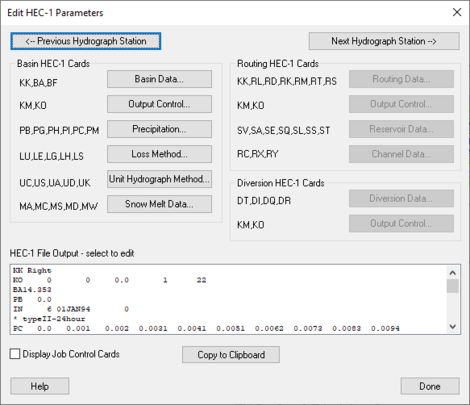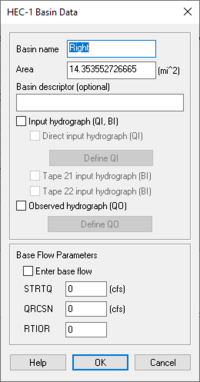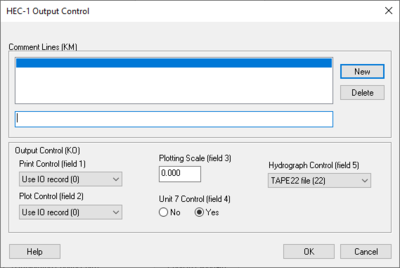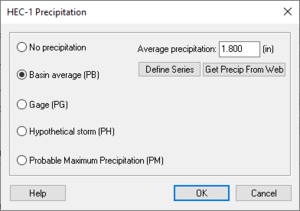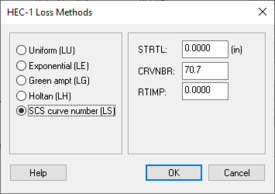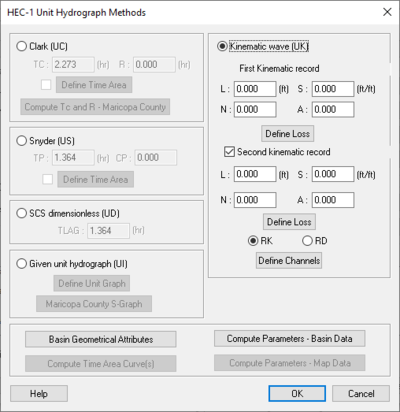User:Kczappa: Difference between revisions
| Line 284: | Line 284: | ||
==RK/RD Channels Dialog== | ==RK/RD Channels Dialog== | ||
[[Image:RK RD Channels Dialog.JPG|thumb|400 px|''HEC-1 RK/RD Channels'' dialog]] | [[Image:RK RD Channels Dialog.JPG|thumb|400 px|''HEC-1 RK/RD Channels'' dialog]] | ||
Accessed by selecting '''Define Channels''' in the Kinematic wave section of the ''HEC-1 Unit Hydrograph Methods'' dialog. | |||
Revision as of 20:53, 9 April 2020
Kayla Czappa
- Aquaveo
Pages On WMS that needs to be done: Edit HEC-1 Parameters Dialog which include:
Basin HEC-1 Cards dialogs that include:
Basin Data... Output Control... Precipitation... Loss Method... Unit Hydrograph Method... Snow Melt Data...
Routing HEC-1 Cards dialogs include:
Routing Data... Output Control... Reservoir Data... Channel Data... Output Control...
HEC-1 File Output (select to edit)
WMS: Edit HEC-1 Parameters dialog
When a basin is selected in the HEC-1 model, selecting HEC-1 | Edit Parameters will bring up the Edit HEC-1 Parameters dialog with the Basin HEC-1 Cards section active. The following can then be specified:
<--Previous Hydrograph Station –
Next Hydrograph Station--> –
Basin HEC-1 Cards section –
- Basin Data... – Allows the specification of Basin Data.
- KK – Basin Name.
- BA – Basin Area.
- BF – Baseflow.
- Output Control... – Allows different output controls to be specified.
- KM – Comment Lines.
- KO – Output Control.
- Precipitation... – Allows the specification of precipitation data.
- PB – Basin Average Precipitation.
- PG – Precipitation Gage.
- PH – Hypothetical Storm.
- PI – Probable Maximum Precipitation.
- PC –
- PM –
- Loss Method... – Allows the specification of Loss Methods being applied.
- LU – Uniform Loss Method.
- LE – Exponential Loss
- LG – Green & Ampt.
- LH – Holtan.
- LS – SCS Loss Method.
- Unit Hydrograph Method... – Allows the specification of Hydrograph methods being applied.
- UC – Clark Unit Hydrograph.
- US – Snyder
- UA –
- UD – SCS Dimensionless.
- UK – Kinematic Wave.
- Snow Melt Data... – Allows the specification of snow melt data.
- MA – Elevation Zone Data.
- MC –
- MS – Shot-Wave Radiation Time Series.
- MD – Dew Point Time Series.
- MW – Wind Speed Time Series.
Routing HEC-1 Cards section –
- 'Routing Data... – Allows the specification of routing data.
- KK –
- RL –
- RD –
- RK –
- RM –
- RT –
- RS –
- Output Control... – Allows different output controls to be specified.
- KM – Comment Lines.
- KO – Output Control.
- Reservoir Data... – Allows the specification of reservoir data.
- SV –
- SA –
- SE –
- SQ –
- SL –
- SS –
- ST –
- Channel Data... – Allows the specification of Channel data.
- AC –
- RX –
- RY –
Diversion HEC-1 Cards section –
- Diversion Data... – Allows the specification of diversion data.
- DT –
- DI –
- DQ –
- DR –
- Output Control... – Allows different output controls to be specified.
- KM – Comment Lines.
- KO – Output Control.
HEC-1 File Output-select to edit section –
"Display Job Control Cards" – By selecting this, it allows the Job Controls to be viewed.
Copy to Clipboard – Allows the information to be copied to the clipboard for any future use.
Help –
Basin Data Dialog
Basin name– Name of the specific Basin that's being defined.
Area – Area of the Basin being defined (mi^2).
Basin Descriptor (OPtional) – Option for more Description of the Basin.
Input hydrograph (QI, BI) –
- "Direct input hydrograph (QI)
- Define QI – Allows for the definition of the direct input hydrograph. Click to open the XY Series Editor dialog.
- Tape 21 input hydrograph (BI) – Select to indicate that the data should be input as a general hydrograph.
- Tape 22 input hydrograph (BI) – Select to indicate that the data should be input as a specific hydrograph.
Observed hydrograph (QO) –
- Define QO – Click to open the XY Series Editor dialog.
Base Flow Parameters
- Enter base flow – Select this to enter the defined base flow.
- STRTQ – Flow at the start of the storm in cfs (cms for metric units).
- QRCSN – Flow in cfs (cms) below which base flow recession occurs in accordance with the recession constant RTIOR. In other words, it is that flow where the straight line (in semilog paper) recession deviates from the falling limb of the hydrograph.
- RTIOR – The ratio of the recession flow (QRCSN) to that flow occurring one hour later (Must be greater than or equal to 1)
Output Control Dialog
Comment Lines section – Section that allows comments to be written out.
- New – Select to add a new comment.
- Delete – Select to delete an existing comment.
Output Control (KO)
- Print Control (field 1) – controls how the data collected is printed.
- "Use IO record (O)" – Default setting, prints the entire IO record.
- "Print all output (1,2)" – When selected, prints all output.
- "Print input and summaries" – When selected, it will just print input and summaries of the data.
- "Print input data only (4)" – When selected, it will print the input data only.
- Plot Control (field 2) – Section where plots can be controlled.
- "Use IO record (O)" – Plots are dependant on the IO record.
- "No printer plots (1)" – Select if there are no printer plots.
- "Plot hydrograph (2)" – Select to receive output on the plot hydrograph.
- Plotting Scale (field 3) – Section to specify the plotting scale.
- Unit 7 Control (field 4) – If the unit 7 control should be on select yes, if not select no.
- Hydrograph Control (field 5) – Section designated to control the output of hydrographs.
- "TAPE22 file (22)" – The file read by WMS for the display of hydrographs. This should only be changed to suppress particular hydrographs.
- "TAPE 21 file (21)" – The file used to suppress particular hydrographs.
Precipitation Dialog
No Precipitation – Select if there was no precipitation. Basin average (PB) – Select to specify the Basin Average.
- Average precipitation: – Enter the average precipitation in inches here.
- Define Series – Select to bring up the XY Series Editor dialog.
- Get Precip From Web – Select to bring up the Get Online NOAA Atlas 14 Data dialog.
Gage (PG) –
- PT Gage Weights – Section where gage weights can be changed/assigned.
- PR Gage Weights – Section where gage weights can be changed/assigned.
Hypothetical storm (PH) – Select to define the characteristics of a hypothetical storm.
- Define Storm – Select to bring up the XY Series Editor dialog.
- Frequency – Enter the frequency of a hypothetical storm here.
- Storm area: – Enter the area of the hypothetical storm in mi^2.
Probable Maximum Precipitation (PM) – Allows for the computation of the probable maximum storm according to the outdated Hydrometeorological Report No. 33 (HMR 33).
- PMS: – Enter the probable maximum index precipitation from the HMR 33. Recorded in inches.
- % of PMS – Click to bring up the HEC-1 Percentage of PMS dialog.
- Maximum 6-hour percentage of PMS – Maximum amount of probable precipitation inside a 6 hour time period.
- Maximum 12-hour percentage of PMS – Maximum amount of probable precipitation inside a 12 hour time period.
- Maximum 24-hour percentage of PMS – Maximum amount of probable precipitation inside a 24 hour time period.
- Maximum 48-hour percentage of PMS – Maximum amount of probable precipitation inside a 48 hour time period.
- Maximum 72-hour percentage of PMS – Maximum amount of probable precipitation inside a 72 hour time period.
- Maximum 96-hour percentage of PMS – Maximum amount of probable precipitation inside a 96 hour time period.
- SWD – Click to open the Precipitation Distribution dialog.
- EM 1110-2-21411 criteria –
- Southwestern Division criteria –
- TRSPC: – Precipitation adjustment (between 0 and 1.0) based on drainage area size. If this value is set at zero HEC-1 will default it to the appropriate value based on the HOP Brook Adjustment Factor as described in the HEC-1 manual.
- TRSDA: – The drainage area in square miles for which the storm is transposed.
HEC-1 Loss Methods Dialog
Uniform (LU) – Losses are used in conjunction with the uniform (LU) or exponential (LE) loss methods.
- STRTL – Initial rainfall/snow melt loss in inches (mm) for snow free ground.
- CNSTL – Uniform rainfall/ loss in inches/hour (mm/hour) which is used after the starting loss (STRTL) has been satisfied.
- RTIMP – Ratio of the drainage basin that is impervious. Values should be less than or equal to 1.
Exponential (LE) – Parameters for the exponential loss method are as follows
- STRKR – The starting value of the loss coefficient on the exponential recession curve for rain losses.
- DLTKR – The amount in inches (mm) of initial accumulated rain loss during which the loss coefficient is increased.
- RTIOL – Parameter computed as the ratio of STRKR to a value of STRKR after ten inches (ten mm) of accumulated loss.
- ERAIN – Exponent of precipitation for rain loss function that reflects the influence of the precipitation rate on basin-average loss characteristics.
- RTIMP – Ratio of the drainage basin that is impervious. Values should be less than or equal to 1.
Green ampt (LG) – Green-Ampt infiltration loss parameters are as follows:
- IA – Initial loss (abstraction) in inches (mm).
- DTHETA – Volumetric moisture deficit. If this value is 0, then the method reduces to the initial loss equal to IA and a constant loss equal to XKSAT.
- PSIF – Wetting front suction in inches (mm). If this value is 0, then the method reduces to the initial loss equal to IA and a constant loss equal to XKSAT.
- XKSAT – Hydraulic conductivity at natural saturation in inches/hour (mm/hour).
- RTIMP – Ratio of the drainage basin that is impervious. Values should be less than or equal to 1.
Holtan (LH) – Parameters used to define the Holtan loss method:
- FC – Holtan's long term equilibrium loss rate in inches/hour (mm/hour) for rainfall/losses on snow free ground.
- GIA – Infiltration rate in inches/hour per inch *BEXP (mm/hour per mm *BEXP) of available soil moisture storage capacity.
- SAI – Initial depth in inches (mm) of pore space in the surface layer of the soil which is available for storage of infiltrated water.
- BEXP – Exponent of available soil moisture storage.
- RTIMP – Ratio of the drainage basin that is impervious. Values should be less than or equal to 1.
SCS curve number (LS) – The SCS curve number method uses the following parameters:
- STRTL – Initial rainfall abstraction in inches (mm) for snowfree ground. If value is 0, then initial abstraction will be computed as:
- .
- CRVNBR – SCS curve number for rainfall/ losses on snowfree ground.
NOTE: Composite Curve Numbers can be computed automatically when this method for computing losses is chosen and a terrain model is present.
- RTIMP – Ratio of the drainage basin that is impervious. Values should be less than or equal to 1.
Unit Hydrograph Method Dialog
Clark (UC) –
- TC: – Measured in hours.
- R: – Measured in hours.
- Define Time Area –
- Compute Tc and R-Maricope County – This option is only available when the selection of Green ampt (LG) or Uniform (LU) Loss method in the HEC-1 Loss Methods dialog has been done.
Snyder (US) –
- TP: – Measured in hours.
- CP: –
- Define Time Area – Select this to allow the definition of the specific time area that is being assessed.
SCS dimensionless (UD) –
- TLAG: – Measured in hours.
Given unit hydrograph (UI) –
- Define Unit Graph – Select to bring up the XY Series Editor dialog.
- Maricope County S-Graph – Select this to bring up the S-Graph Option dialog.
- S-Graph Types section –
- "Phoenix Valley" –
- "Phoenix Mountain" –
- "Desert rangeland" –
- "Agricultural" –
- S-Graph Types section –
- Basin area=31.8901 (sq. miles)
- Basin Lag Time: – Measured in minutes.
- Computational Time Step: – 15 minutes.
Kinematic Wave (UK) –
- First Kinematic Record ‐
- L: – Represents the Overland flow length (measured in ft).
- S: – Representative slope (measured in ft/ft).
- N: – Represents Manning's roughness coefficient.
- A: – Represents the percentage of sub-basins area that this record represents (The total of the two records must be the sum of 100).
- Define Loss – Click to open the HEC-1 Loss Methods dialog.
- Second Kinematic Record –
- L: – Represents the Overland flow length (measured in ft).
- S: – Representative slope (measured in ft/ft).
- N: – Represents Manning's roughness coefficient.
- A: – Represents the percentage of sub-basins area that this record represents (The total of the two records must be the sum of 100).
- Define Loss – Click to open the HEC-1 Loss Methods dialog.
- RK –
- RD –
- Define Channels – Click to open the RK/RD Channels dialog.
- Basin Geometrical Attributes –
- Compute Parameters-Basin Data –
- Compute Time Area Curve(s) –
- Compute Parameters-Map Data –
Snow Melt Data Dialog
Routing Data Dialog
Reservoir Data Dialog
Channel Data Dialog
Diversion Data Dialog
RK/RD Channels Dialog
Accessed by selecting Define Channels in the Kinematic wave section of the HEC-1 Unit Hydrograph Methods dialog.
